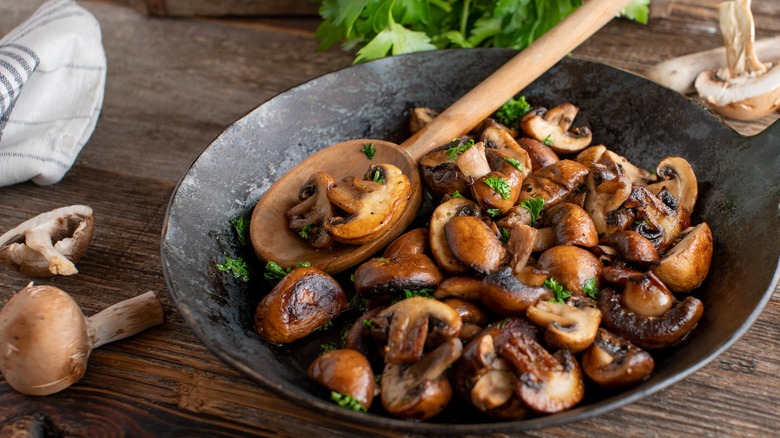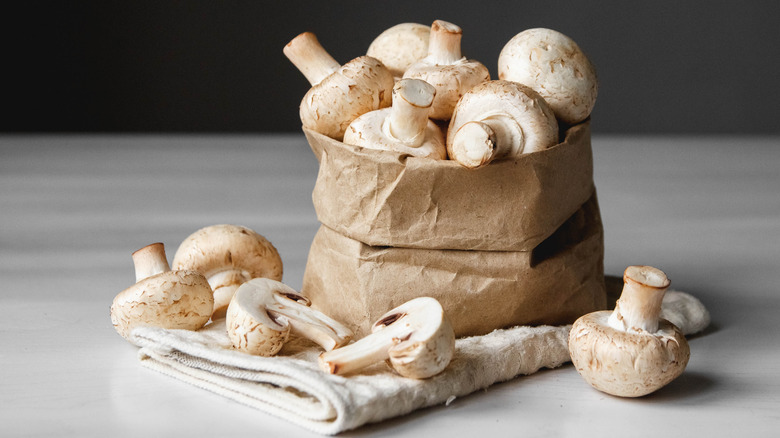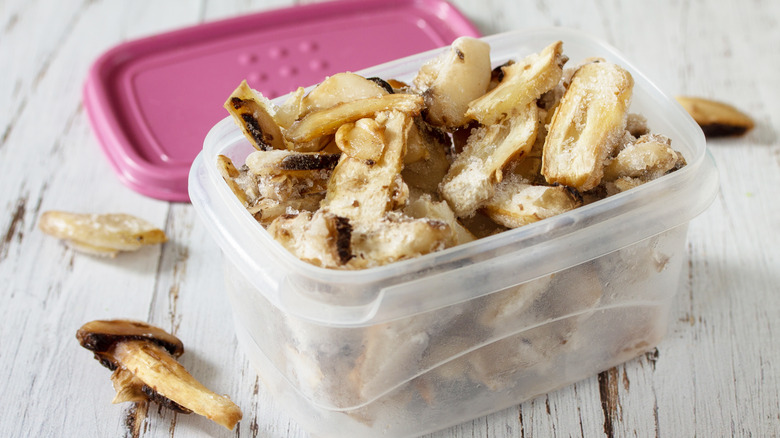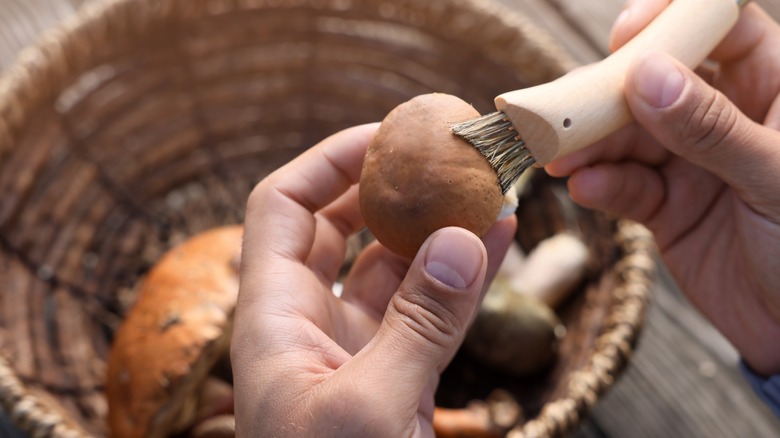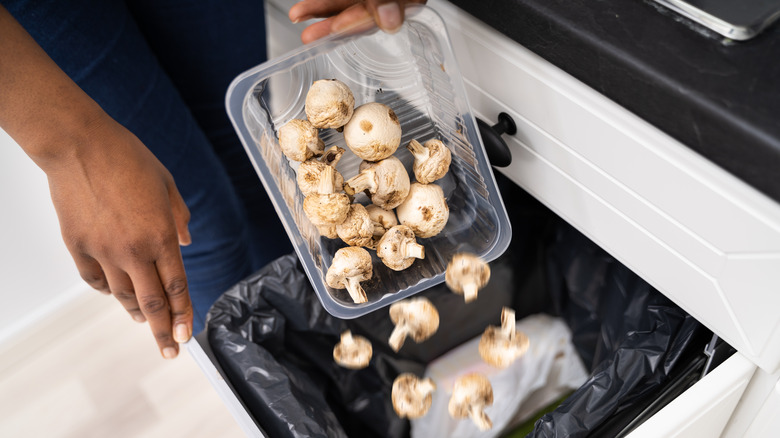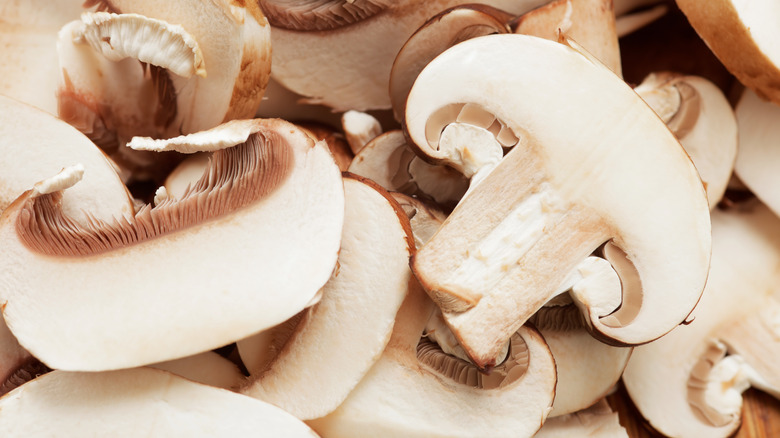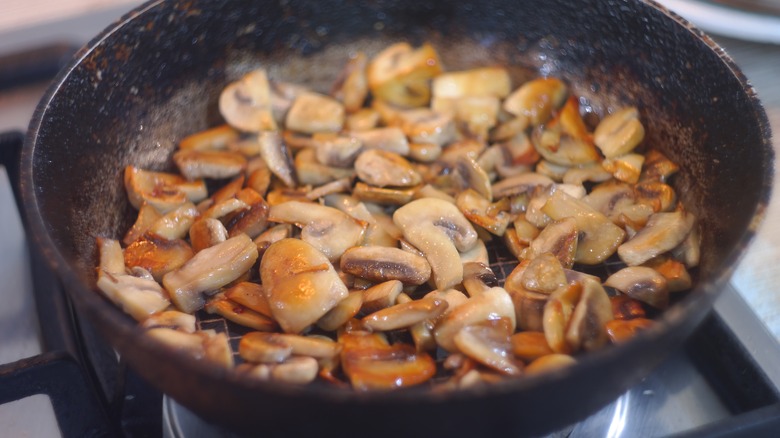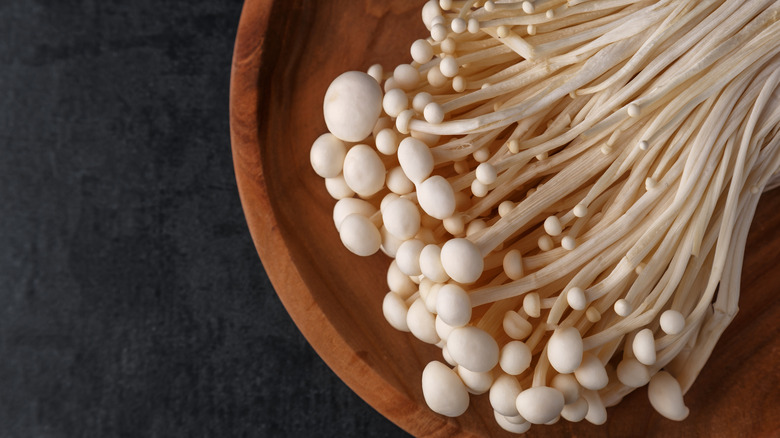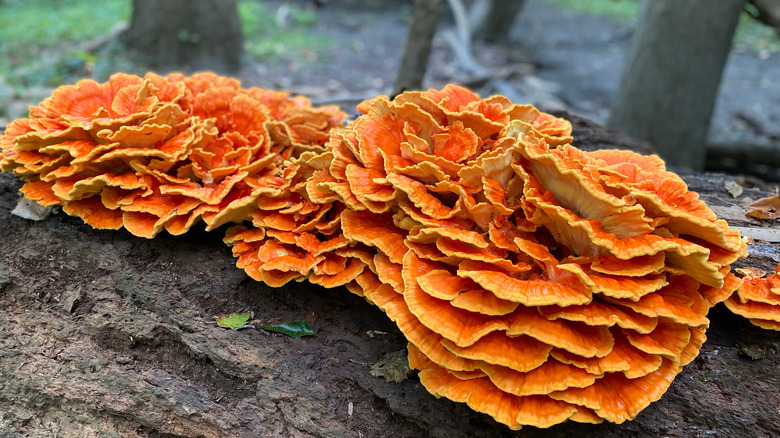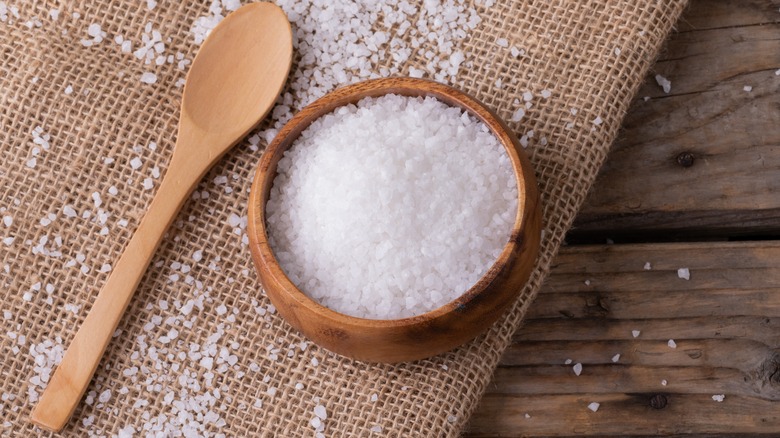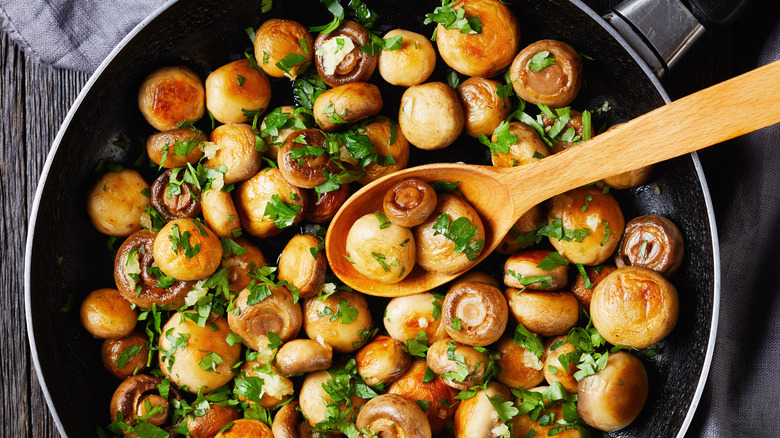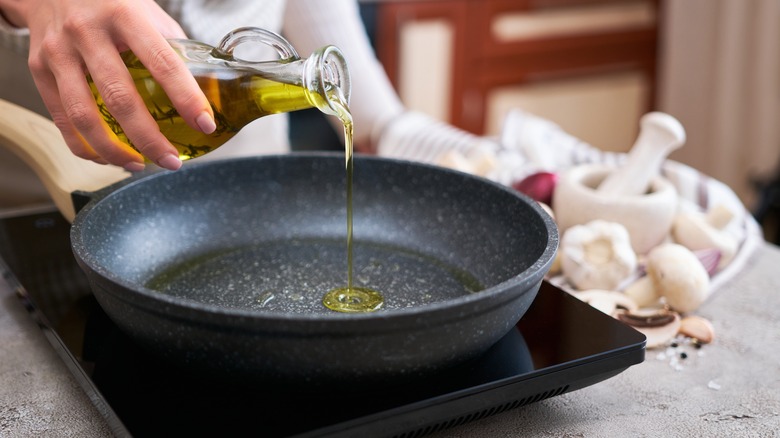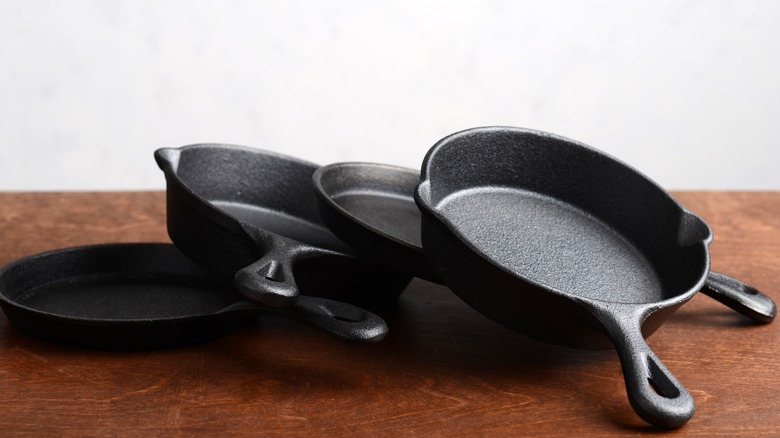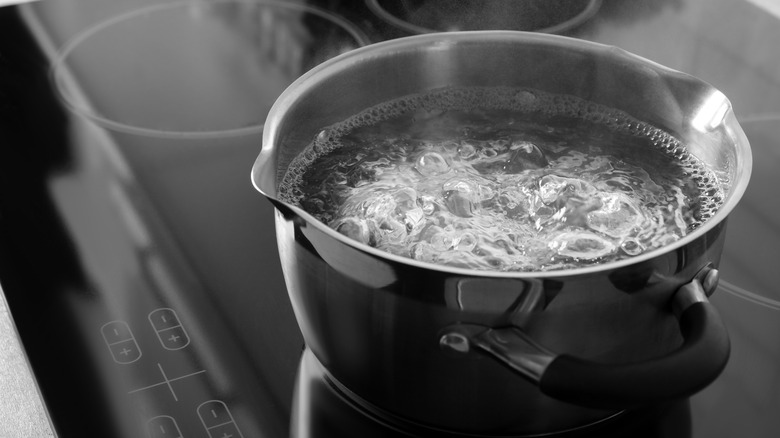The Biggest Mistakes You Can Make While Cooking Mushrooms
If you're ready to elevate your mushroom game, you'll want to avoid a few cooking mistakes. Even if you've been cooking mushrooms for most of your life, you might learn a thing or two about how to make them even better. Some of the mistakes start before we ever get them into the pan, so it's essential to know things like how to avoid ones that have gone bad, how to store them, as well as all the ins and outs of cooking them.
From cooking time to temperature and from when to add salt to the type of oil you use, so many things matter to achieve the results you want with your mushrooms. We've even uncovered a mushroom cooking technique that you've likely been missing out on. So, if you're ready to become a next-level mushroom-cooking expert, you're going to want to know what you've been doing wrong so that you can do everything right going forward.
Storing them incorrectly
When most of us buy mushrooms, we have a habit of leaving them in the cartons, wrapped up in plastic wrap as they came right from the store. Unfortunately, a larger percentage of the mushrooms are likely to spoil faster when stored this way. So, if you find yourself usually throwing out half or all of your mushrooms before using them, the trick is learning how you store them properly.
To keep a larger portion of your mushrooms from spoiling, you should immediately remove them from their packaging after you get them home. Then, wrap the mushrooms in paper towels (without washing them) to absorb excess moisture. After they're wrapped, place them in an open paper bag in the fridge. According to one experiment, the paper bag and paper towel storage method is the best one for keeping more of your mushrooms slime-free the longest. It's also a good method for storing foraged mushrooms. Storing them in a paper bag or paper towels in the fridge is also better than storing them in the original packaging, but still not as good as using them together. Storing mushrooms in a plastic bowl with plastic wrap in the fridge is comparable to storing them in the original packaging. However, the fastest way to spoil your mushrooms is to keep them in paper towels in a plastic bag in the fridge.
Using frozen mushrooms
If you've ever frozen an overabundance of mushrooms to keep them from going bad, you've probably experienced the unappetizing, rubbery results. The reason that mushrooms end up with such a disappointing texture when you freeze them is because they're about 80% water. Thus, your mushrooms — true to their name — become mushy upon thawing. Not only do they change their texture, but, according to Healthline, the amount of water-soluble nutrients in them decreases. So, you can expect the frozen ones to contain less folate, niacin, and riboflavin.
While the texture still won't be perfect, you can still improve the texture of frozen mushrooms by steam-blanching or sautéing them before freezing. Steam-blanch them in a mixture of 4 cups water and a teaspoon of lemon juice for 3 to 5 minutes. The lemon helps prevent discoloration. Then, give them an ice water bath for 3 to 5 minutes before drying, and freeze them in an airtight container. To sauté them, put them in a pan with hot oil or butter for 5 minutes. Then, wait for them to cool before moving them to the freezer in an airtight container.
Not cleaning them properly
You can either wash, brush, or wipe mushrooms to clean them. However, there's a wrong and right way when it comes to those methods. Many sources suggest brushing the dirt off of them with a brush or wiping the dirt off with a soft damp cloth or damp paper towel rather than washing them. The main reason for this suggestion is that they readily absorb water. However, experiments indicate that the weight of whole mushrooms doesn't increase a lot during washing. So, it's fine to rinse them before cooking. You shouldn't rinse them before you're ready to use them because they absorb water so easily. They will go slimy before you get a chance to cook with them. If rinsing, it's important to rinse before slicing since sliced mushrooms absorb more water. After rinsing, you'll want to gently dry them with a paper towel, soft cloth, or salad spinner to remove as much water as possible before cooking (unless you plan to boil them).
You should especially wash foraged mushrooms before cooking. After all, most people don't relish the idea of bark, bugs, and other forest debris in their food. It's best to dunk ones with ruffly masses in a bowl of water to remove debris you can't easily see. Cut off any discolored areas and scrape out any wood or other debris that have become embedded in the mushroom during the growing process.
Not knowing how to identify when mushrooms have gone bad
Being able to tell good mushrooms from bad is necessary from the point of purchase to the moment you're ready to turn them into a delightful meal. Even when you're cooking a species that is generally safe to eat, they can still make you sick if they've gone bad. Eating bad mushrooms can lead not only to food poisoning but to serious health problems.
According to Consumer Health Digest, some signs that mushrooms have gone bad include becoming slimy or sticky, shriveling and developing wrinkles, becoming darker, or developing dark spots. They can even become moldy. Bad smells beyond the normal earthy and fungus-like smell of the average mushroom can also indicate that something is wrong. So, if they start to smell like fish or something else, toss them. Botulism grows in an oxygen-free environment, so if you open up a can or package of mushrooms that are bulging and smell bad, it could be a sign that it's contaminated. According to the CDC, untreated botulism can result in a variety of symptoms from blurred vision to full paralysis. You'll also want to toss mushrooms out of caution if they've been in your fridge for more than a couple of weeks. If they're sliced, they're only good for a week or less.
Not cooking them long enough
It's essential to cook mushrooms well for a variety of reasons. One reason relates to health while another relates to flavor. Mycologist (mushroom scientist) Paul Stamets says that the human body can't digest raw mushrooms well because their cell walls are so tough. So, it's essential to cook them for our body to be able to use their nutrients. Stamets also says that "Raw mushrooms and raw mycelium may pose health hazards from harmful pathogens and heat-sensitive toxins — potentially causing red blood cell damage, gastrointestinal irritation, and allergic reactions, such as skin rashes." So, you'll want to watch for your mushrooms to lightly brown to ensure they're cooked rather than still raw when you eat them.
Mushrooms taste best and develop the best texture when cooked slowly using dry heat. The slow cooking time helps remove much of the water in the mushroom while concentrating the sugars and amino acids for a more flavorful and aromatic result.
Not cooking them at the right temperature
Mycologist Paul Stamets says, "Edible mushrooms should be tenderized by heating to at least 140 F — more preferably over 180 F — most preferably above 200 F to release their nutrients and render them digestible and safe." It's also essential to do more than just flash cooking with them.
According to Rapid Microbiology, mushrooms can harbor pathogens like Salmonella, Listeria, and Staphylococcus that they acquire during growing, processing, or even in your home. Even heat-treated canned mushrooms are at risk if some of the bacteria survive the heating process and have time to multiply in the can. According to a study in Applied Microbiology, you need to cook them for at least 12 minutes at 150 F or higher to kill off the most tenacious of these pathogens. If you're only getting the temperature up to 140 F, you'd have to cook them for 78 to 83 minutes to make the mushrooms safe to eat. So, higher temperatures are better if you don't plan to cook them long and slow.
Not branching out to try other varieties
When your recipe calls for mushrooms, it's easy to just grab a package of tried-and-true button mushrooms from the store. However, there are so many more, and they have a variety of textures and flavors. Once you've tried the button mushrooms and portobello mushrooms your local grocery store has to offer, we challenge you to seek out others from an Asian market, farmer's market, or even through foraging. You might even try keeping dried mushrooms on hand to add strong umami flavors to your recipes.
Cremini have a slightly stronger flavor than button mushrooms, so they could be the first ones you try. Portobellos are even richer but still in the same flavor family. Shiitakes are bursting with intense and earthy flavors and may be a step outside the norm. Even more fun is finding delicate and mild strands of enoki mushrooms at an Asian market.
Even if you don't feel confident enough to forage yourself, you might find some great foraged gems at the farmer's market. Some include the seafood-like oyster mushroom, the woodsy chanterelle, the smoky and nutty morel, and the lobster-like lion's mane. The real treat is chicken of the woods with a taste and texture like chicken.
Not using mushrooms with the right flavor profile or texture for your dish
Once you start branching out into the world of mushrooms, it's important to know the flavor and texture profile of the type you have before you start cooking with it. You can ruin a dish quickly by adding a mushroom with an odd flavor or texture. When in doubt, consult a list of types of mushrooms and what they're used for before you get started.
White button mushrooms, cremini, and portobello are all the same species at different maturity levels and are great for stuffing, grilling, sautéing, and adding to sauces. However, you'll want to be careful when using ones like oyster mushrooms and lion's mane that have a more seafood-forward flavor if you don't want your dish to taste fishy. You can use chicken of the woods as a chicken substitute. For an intense umami flavor, dried mushrooms may be what you seek. Meanwhile, some others are all about adding an interesting texture. Enoki's crunchy texture and matchstick-like arrangement are fun in soups or wraps. And chewy wood ear mushrooms are interesting additions to Asian dishes.
Adding salt at the wrong time
While many foods are best salted at the beginning of cooking, mushrooms aren't among them. So, if you've been salting mushrooms the wrong way, it's time to rethink your cooking strategy. Salting them after cooking affects more than just your mushrooms' flavor.
Experiments show that, when you add salt to mushrooms from the start, a few things happen. First of all, they cook more slowly, and the flavor and texture suffer as well. When you salt them from the beginning, you'll notice that they don't have as strong of a flavor and that they don't get as tender. However, when you wait until the end of the cooking process to salt them, you get much better results in the flavor and tenderness area. Plus, they even cook faster.
If you want the mushrooms to blend into your dish without being too noticeable, then go ahead and salt them whenever you want. If mushrooms are the star of the dish, salt them at the end. If other ingredients in the dish require early salting, you might want to consider cooking your mushrooms separately and then adding everything together at the end.
Overcrowding the pan when sautéing
If you're sautéing mushrooms in hopes of getting beautifully browned results, one of the best things you can do is keep from overcrowding the pan. Since mushrooms are so full of moisture in the first place, putting them next to each other will result in more of a soggy effect than a browned effect.
When you give mushrooms more space in the pan, the moisture that escapes during cooking can more easily evaporate. When there are too many too close together, you end up creating a stewing or steaming environment. Since mushrooms shrink as they cook, you don't have to worry so much about making sure none of the mushrooms are touching. However, you do want to make sure there's just one layer of mushrooms so that the moisture from the top layer isn't leaching into the bottom layer. If you need more mushrooms, just make them in multiple batches rather than sacrifice the texture by trying to get all of them done at once. If you have enough open stove burners and enough pans, you can just have multiple pans of mushrooms going at once.
Not using the right type of fat
Something else to consider is the type of fat that you use, especially if you're trying to achieve browned mushrooms. Different types yield different results. The water content of the fat you use should be a consideration. While butter provides a delicious flavor for mushrooms, using it can make it difficult to brown them. With butter having around 15% water itself, it can make more of a sauce when combined with all the liquid that oozes out of the mushrooms. If that's your goal, fine. For browning, it's best to look to oils with less moisture like olive oil. Since oil tends not to mix with the moisture that comes out of mushrooms as they cook, some cooks opt not to use any fat at all.
The oil you use ultimately depends on the texture end result and the flavor profile you want. Butter might be great if you're making a sauce. However, if you're adding it to an Italian dish like pasta, olive oil may be the better choice. You could even sautée them in bacon grease if you wanted the fat to impart extra flavor.
Not trying them smashed
If you like crisp, browned mushrooms, you've been making a big mistake if you haven't been smashing them during the cooking process. This process yields mushrooms that are next level and worthy of comment at the dinner table. If you've ever made chicken extra brown and crisp by cooking it under a brick, it's a similar concept.
To smash your mushrooms, you'll need two different-sized iron skillets that can nest one inside of the other. You'll start by sautéing your mushrooms in oil as usual in the larger skillet. Once the mushrooms start to sizzle and brown, it's time to nest the smaller pan inside the larger skillet and on top of the mushrooms. The weight of the second skillet will smash the mushrooms more flush with the pan, giving it a chance to brown better. You might want to smash the skillet down harder occasionally or even add extra weight to the skillet (like adding cans of food) to achieve an even deeper browning effect. When the first side has browned to your liking, you'll need to flip the mushrooms to brown on the other side. The smashing technique works for any type of mushroom. However, it's especially nice for frilly types with more hidden areas like lion's mane or for ones like enoki that come in clumps. Smashing these mushrooms allows even more surface area contact with the heat for delightful results.
Not boiling them first before sautéing
Boiling your mushrooms before sautéing them might sound odd. However, it solves a lot of the problems we've previously mentioned concerning cooking mushrooms. Plus, you'll end up with mushrooms that brown faster and better, taste somewhat meatier, and have a juicier texture.
For one thing, when you boil mushrooms, they start to lose a lot of their excess moisture. They also shrink as they release the moisture. So, when you get them to the pan, you don't have to worry nearly as much about overcrowding because they have less moisture to expel. Without having to worry about overcrowding, you can cook more at a time rather than need to cook them in batches. The overall time for cooking is the same since you only need to boil the mushrooms for 3 to 5 minutes and the sautéing time is shorter. After boiling, drain them and remove water with a paper towel, cloth, or salad spinner before sautéing and finishing as usual.
